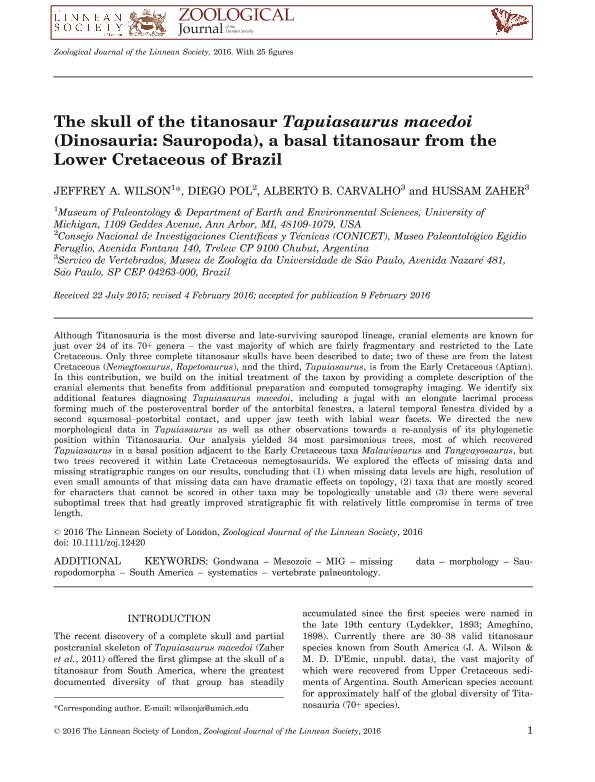Mostrar el registro sencillo del ítem
dc.contributor.author
Wilson, Jeffrey A.
dc.contributor.author
Pol, Diego

dc.contributor.author
Carvalho, Alberto B.
dc.contributor.author
Zaher, Hussam
dc.date.available
2018-05-28T17:31:17Z
dc.date.issued
2016-11
dc.identifier.citation
Wilson, Jeffrey A.; Pol, Diego; Carvalho, Alberto B.; Zaher, Hussam; The skull of the titanosaur Tapuiasaurus macedoi (Dinosauria: Sauropoda), a basal titanosaur from the Lower Cretaceous of Brazil; Wiley Blackwell Publishing, Inc; Zoological Journal of the Linnean Society; 178; 3; 11-2016; 611-662
dc.identifier.issn
0024-4082
dc.identifier.uri
http://hdl.handle.net/11336/46282
dc.description.abstract
Although Titanosauria is the most diverse and late-surviving sauropod lineage, cranial elements are known for just over 24 of its 70+ genera - the vast majority of which are fairly fragmentary and restricted to the Late Cretaceous. Only three complete titanosaur skulls have been described to date; two of these are from the latest Cretaceous (Nemegtosaurus, Rapetosaurus), and the third, Tapuiasaurus, is from the Early Cretaceous (Aptian). In this contribution, we build on the initial treatment of the taxon by providing a complete description of the cranial elements that benefits from additional preparation and computed tomography imaging. We identify six additional features diagnosing Tapuiasaurus macedoi, including a jugal with an elongate lacrimal process forming much of the posteroventral border of the antorbital fenestra, a lateral temporal fenestra divided by a second squamosal–postorbital contact, and upper jaw teeth with labial wear facets. We directed the new morphological data in Tapuiasaurus as well as other observations towards a re-analysis of its phylogenetic position within Titanosauria. Our analysis yielded 34 most parsimonious trees, most of which recovered Tapuiasaurus in a basal position adjacent to the Early Cretaceous taxa Malawisaurus and Tangvayosaurus, but two trees recovered it within Late Cretaceous nemegtosaurids. We explored the effects of missing data and missing stratigraphic ranges on our results, concluding that (1) when missing data levels are high, resolution of even small amounts of that missing data can have dramatic effects on topology, (2) taxa that are mostly scored for characters that cannot be scored in other taxa may be topologically unstable and (3) there were several suboptimal trees that had greatly improved stratigraphic fit with relatively little compromise in terms of tree length.
dc.format
application/pdf
dc.language.iso
eng
dc.publisher
Wiley Blackwell Publishing, Inc

dc.rights
info:eu-repo/semantics/openAccess
dc.rights.uri
https://creativecommons.org/licenses/by-nc-sa/2.5/ar/
dc.subject
Gondwana
dc.subject
Mesozoic
dc.subject
Mig
dc.subject
Missing Data
dc.subject
Morphology
dc.subject
Sauropodomorpha
dc.subject
South America
dc.subject
Systematics
dc.subject
Vertebrate Palaeontology
dc.subject.classification
Meteorología y Ciencias Atmosféricas

dc.subject.classification
Ciencias de la Tierra y relacionadas con el Medio Ambiente

dc.subject.classification
CIENCIAS NATURALES Y EXACTAS

dc.title
The skull of the titanosaur Tapuiasaurus macedoi (Dinosauria: Sauropoda), a basal titanosaur from the Lower Cretaceous of Brazil
dc.type
info:eu-repo/semantics/article
dc.type
info:ar-repo/semantics/artículo
dc.type
info:eu-repo/semantics/publishedVersion
dc.date.updated
2018-05-28T14:38:18Z
dc.journal.volume
178
dc.journal.number
3
dc.journal.pagination
611-662
dc.journal.pais
Reino Unido

dc.journal.ciudad
Londres
dc.description.fil
Fil: Wilson, Jeffrey A.. University of Michigan; Estados Unidos
dc.description.fil
Fil: Pol, Diego. Consejo Nacional de Investigaciones Científicas y Técnicas; Argentina. Museo Paleontológico Egidio Feruglio; Argentina
dc.description.fil
Fil: Carvalho, Alberto B.. Universidade de Sao Paulo; Brasil
dc.description.fil
Fil: Zaher, Hussam. Universidade de Sao Paulo; Brasil
dc.journal.title
Zoological Journal of the Linnean Society

dc.relation.alternativeid
info:eu-repo/semantics/altIdentifier/doi/https://dx.doi.org/10.1111/zoj.12420
dc.relation.alternativeid
info:eu-repo/semantics/altIdentifier/url/https://academic.oup.com/zoolinnean/article/178/3/611/2667466
Archivos asociados
